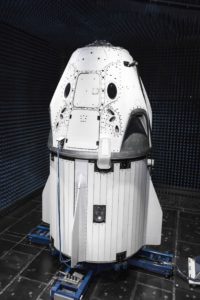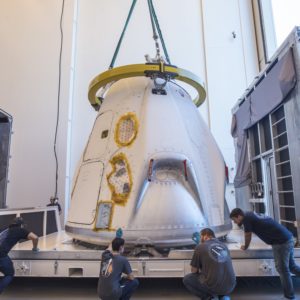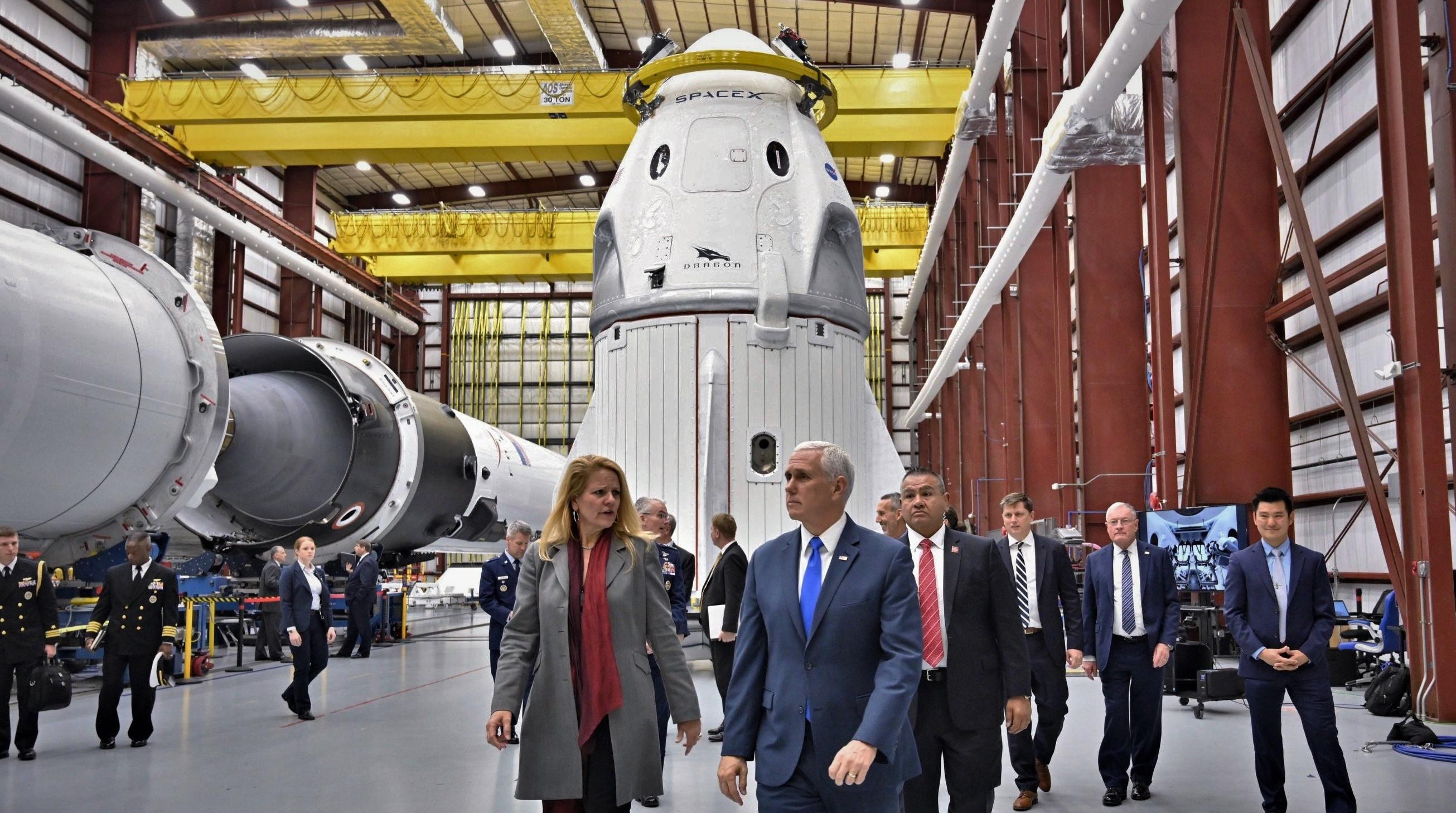

SpaceX
SpaceX shows off first completed Crew Dragon spaceship with new Falcon 9
New photos posted from an official tour of SpaceX’s Pad 39A launch facilities reveal that SpaceX has effectively completed integration and preflight preparations of the company’s first flightworthy Crew Dragon spacecraft, as well as the new Falcon 9 Block 5 rocket that will be tasked with launching it early next year.
Currently targeting launch no earlier than (NET) January 17th, this inaugural Crew Dragon launch – known as Demonstration Mission 1 (DM-1) – will be conducted without a crew aboard to ensure that the spacecraft’s performance and characteristics fit within design parameters, hopefully giving NASA the data it needs to certify Crew Dragon to launch astronauts as early as June 2019.
omfg @spacex just posted some absolutely stunning photos inside Pad 39A's hangar: meet the first completed Crew Dragon and its Falcon 9 Block 5 rocket (B1051) 😀 In the far left (second photo), you can also see what is probably B1047 in the midst of refurbishment. pic.twitter.com/NWULyAEhpQ
— Eric Ralph (@13ericralph31) December 18, 2018
Aside from the wonderful fact that all (or nearly all) of the hardware needed for Crew Dragon’s launch debut can be seen in the four photos posted today, this is also the first time SpaceX has ever provided a real photo of the next-gen spacecraft’s trunk-based solar array. A dramatic departure from Cargo Dragon’s more traditional duo of multi-panel solar arrays, which deploy from disposable covers and fold out like wings, SpaceX decided from the start that Crew Dragon would take a much different approach. In a move that presumably cut the risk of solar array deployment, Crew Dragon’s panels are conformally attached (i.e. curved to fit) to the disposable trunk’s rear exterior.
Incredible opportunity to see @SpaceX's Dragon 2 Capsule – an important part of the future of American human space exploration as we aim to return American astronauts to space on U.S. rockets from U.S. soil! pic.twitter.com/Pk5lkpOFEX
— Vice President Mike Pence Archived (@VP45) December 18, 2018
Rather than deploying its arrays like wings, Crew Dragon will always have its solar cells ready and waiting to generate power, simply requiring the spacecraft to face one half of its trunk towards the sun. According to a few individuals involved with the trunk, guaranteeing food fitment between individual cells and subsections and avoiding the problems caused by different thermal expansion coefficients (shrinking and expanding as the temperature changes) was no easy task and led to many, many headaches in the final weeks of integration and testing. From a less objective standpoint, Crew Dragon’s new conformal solar array is absolutely stunning, and it will be a shame to see each sculpture-like trunk relegated to a destructive atmospheric reentry after each launch.
Pragmatically speaking, it’s extremely satisfying to see all the hardware (both rocket and spacecraft) effectively under the same roof at the launch pad they will soon lift off from. Much like Falcon Heavy, NASA’s Commercial Crew Program (CCP) has been beset with the better part of two years of delays from original launch targets in 2017 for both Boeing and SpaceX. Since then, a combination of NASA bureaucracy and technical/programmatic stumbles made by both companies have conspired to almost indefinitely delay the first uncrewed and crewed trips to orbit.
- At long last, SpaceX’s first completed Crew Dragon has been integrated with a flightworthy trunk and is awaiting attachment to Falcon 9. (SpaceX)
- The first complete Crew Dragon is likely just days away from rolling out to Pad 39A atop Falcon 9. (SpaceX)
- The DM-1 Crew Dragon testing inside SpaceX’s anechoic chamber, May 2018. (SpaceX)
- SpaceX’s Demo Mission-1 Crew Dragon seen preparing for vacuum tests at a NASA-run facility, June 2018. (SpaceX)
- The first spaceworthy Crew Dragon capsule is already in Florida, preparing for its November 2018 launch debut. The same capsule will be refurbished and reflown as few as three months after recovery. (SpaceX)
- Crew Dragon arrives at ISS. (SpaceX)
- DM-2 astronauts Bob Behnken and Doug Hurley train for their first flight in Crew Dragon. (NASA)
SpaceX suffered catastrophic Falcon 9 failures in both 2015 and 2016 and has largely been working to ameliorate the technical and organizational flaws that allowed those anomalies to occur, while also having to convince NASA that they are ready to safeguard the lives of the space agency’s astronauts. Since SpaceX’s last known total vehicle failure in September 2016, Falcon 9 and Falcon Heavy have managed an extraordinary 37 successful launches in a row in a little more than 24 months.
SpaceX is targeting Crew Dragon’s first orbital launch sometime in January 2019, with the placeholded launch date currently sitting on January 17th, pending International Space Station (ISS) availability and NASA’s go-ahead. Given the presence of Falcon 9 B1051 in 39A’s integration hangar and the fact that SpaceX technicians already appear to be integrating the first and second stages, the company may well be ready to perform a full-up dress rehearsal – involving Falcon 9 and Crew Dragon rolling out and going vertical on Pad 39A – before 2018 is out.
For prompt updates, on-the-ground perspectives, and unique glimpses of SpaceX’s rocket recovery fleet check out our brand new LaunchPad and LandingZone newsletters!
Elon Musk
Elon Musk reveals SpaceX’s target for Starship’s 10th launch
Elon Musk has revealed SpaceX’s target timeline for the next Starship launch, which will be the tenth in program history.
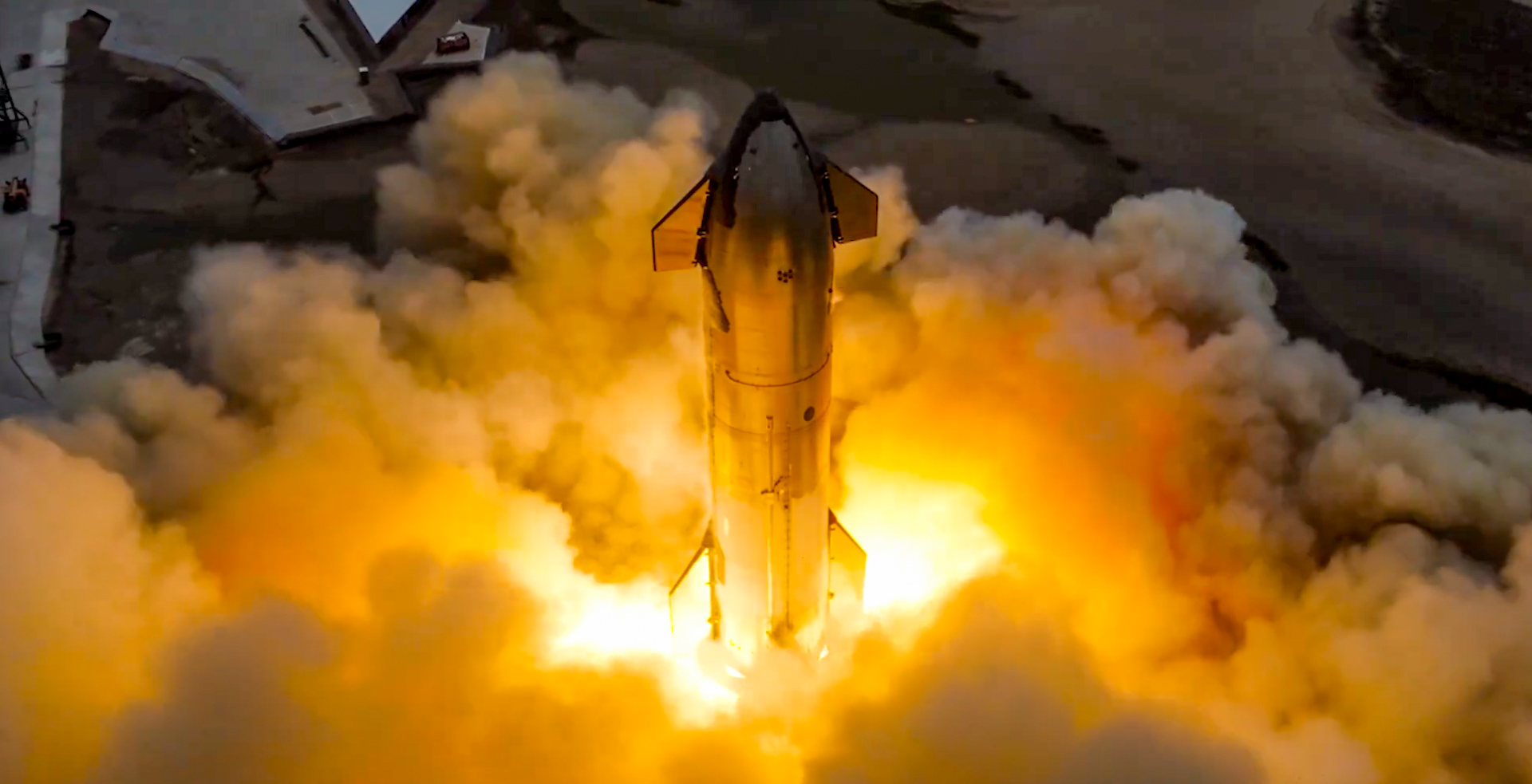
Elon Musk has revealed SpaceX’s target timeline for the next Starship launch, which will be the tenth in program history.
Musk says SpaceX is aiming for a timeline of roughly three weeks from now, which would come about ten weeks after the previous launch.
Coincidentally, it would bring the two launches 69 days apart, and if you know anything about Elon Musk, that would be an ideal timeline between two launches.
🚨 Just wanted you to know, Starship 10’s projected test flight date, according to Grok, is August 4.
Starship’s ninth test flight took place on May 27.
August 4 is 69 days after May 27.
Do with that what you will. 🚀 https://t.co/IISpT08rIy
— TESLARATI (@Teslarati) July 16, 2025
SpaceX is coming off a test flight in which it lost both the Super Heavy Booster and the Upper Stage in the previous launch. The Super Heavy Booster was lost six minutes and sixteen seconds into the flight, while SpaceX lost communication with the Ship at 46 minutes and 48 seconds.
Musk is aiming for the tenth test flight to take place in early August, he revealed on X:
Launching again in ~3 weeks
— Elon Musk (@elonmusk) July 14, 2025
This will be SpaceX’s fourth test flight of the Starship program in 2025, with each of the previous three flights bringing varying results.
IFT-7 in January brought SpaceX its second successful catch of the Super Heavy Booster in the chopstick arms of the launch tower. The ship was lost after exploding during its ascent over the Turks and Caicos Islands.
IFT-8 was on March 6, and SpaceX caught the booster once again, but the Upper Stage was once again lost.
The most recent flight, IFT-9, took place on May 27 and featured the first reused Super Heavy Booster. However, both the Booster and Upper Stage were lost.
The Federal Aviation Administration (FAA) hit SpaceX with a mishap investigation for Flight 9 on May 30.
News
SpaceX’s Crew-11 mission targets July 31 launch amid tight ISS schedule
The flight will lift off from Launch Complex 39A at Kennedy Space Center in Florida.

NASA and SpaceX are targeting July 31 for the launch of Crew-11, the next crewed mission to the International Space Station (ISS). The flight will lift off from Launch Complex 39A at Kennedy Space Center in Florida, using the Crew Dragon Endeavour and a Falcon 9 booster.
Crew Dragon Endeavour returns
Crew-11 will be the sixth flight for Endeavour, making it SpaceX’s most experienced crew vehicle to date. According to SpaceX’s director of Dragon mission management, Sarah Walker, Endeavour has already carried 18 astronauts representing eight countries since its first mission with NASA’s Bob Behnken and Doug Hurley in 2020, as noted in an MSN report.
“This Dragon spacecraft has successfully flown 18 crew members representing eight countries to space already, starting with (NASA astronauts) Bob (Behnken) and Doug (Hurley) in 2020, when it returned human spaceflight capabilities to the United States for the first time since the shuttle retired in July of 2011,” Walker said.
For this mission, Endeavour will debut SpaceX’s upgraded drogue 3.1 parachutes, designed to further enhance reentry safety. The parachutes are part of SpaceX’s ongoing improvements to its human-rated spacecraft, and Crew-11 will serve as their first operational test.
The Falcon 9 booster supporting this launch is core B1094, which has launched in two previous Starlink missions, as well as the private Ax-4 mission on June 25, as noted in a Space.com report.
The four-members of Crew-11 are NASA astronauts Zena Cardman and Mike Fincke, as well as Japan’s Kimiya Yui and Russia’s Oleg Platonov.
Tight launch timing
Crew-11 is slated to arrive at the ISS just as NASA coordinates a sequence of missions, including the departure of Crew-10 and the arrival of SpaceX’s CRS-33 mission. NASA’s Bill Spetch emphasized the need for careful planning amid limited launch resources, noting the importance of maintaining station altitude and resupply cadence.
“Providing multiple methods for us to maintain the station altitude is critically important as we continue to operate and get the most use out of our limited launch resources that we do have. We’re really looking forward to demonstrating that capability with (CRS-33) showing up after we get through the Crew-11 and Crew-10 handover,” Spetch stated.
News
SpaceX launches Ax-4 mission to the ISS with international crew
The SpaceX Falcon 9 launched Axiom’s Ax-4 mission to ISS. Ax-4 crew will conduct 60+ science experiments during a 14-day stay on the ISS.
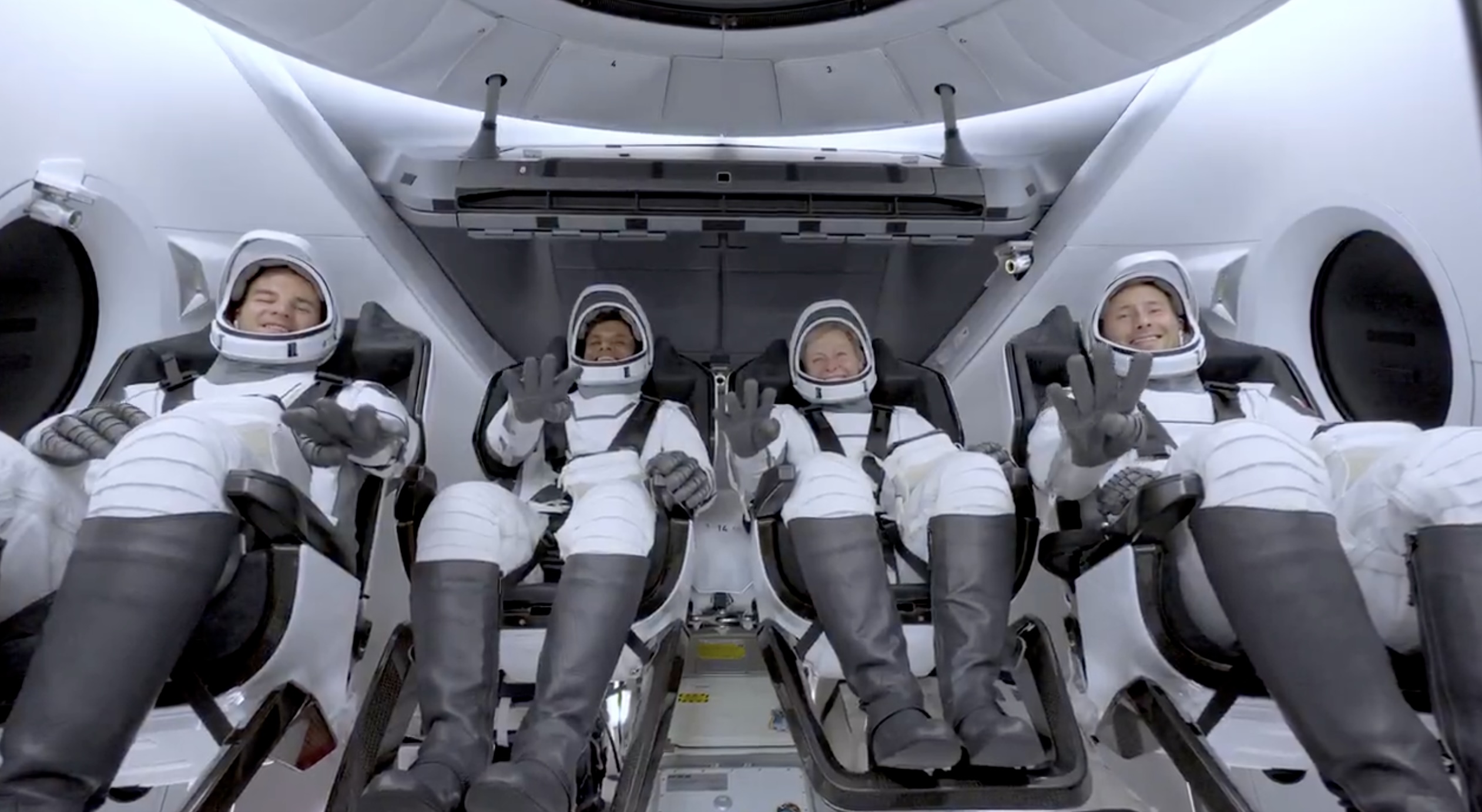
SpaceX launched the Falcon 9 rocket kickstarting Axiom Space’s Ax-4 mission to the International Space Station (ISS). Axiom’s Ax-4 mission is led by a historic international crew and lifted off from Kennedy Space Center’s Launch Complex 39A at 2:31 a.m. ET on June 25, 2025.
The Ax-4 crew is set to dock with the ISS around 7 a.m. ET on Thursday, June 26, 2025. Axiom Space, a Houston-based commercial space company, coordinated the mission with SpaceX for transportation and NASA for ISS access, with support from the European Space Agency and the astronauts’ governments.
The Ax-4 mission marks a milestone in global space collaboration. The Ax-4 crew, commanded by U.S. astronaut Peggy Whitson, includes Shubhanshu Shukla from India as the pilot, alongside mission specialists Sławosz Uznański-Wiśniewski from Poland and Tibor Kapu from Hungary.
“The trip marks the return to human spaceflight for those countries — their first government-sponsored flights in more than 40 years,” Axiom noted.
Shukla’s participation aligns with India’s Gaganyaan program planned for 2027. He is the first Indian astronaut to visit the ISS since Rakesh Sharma in 1984.
Axiom’s Ax-4 mission marks SpaceX’s 18th human spaceflight. The mission employs a Crew Dragon capsule atop a Falcon 9 rocket, designed with a launch escape system and “two-fault tolerant” for enhanced safety. The Axiom mission faced a few delays due to weather, a Falcon 9 leak, and an ISS Zvezda module leak investigation by NASA and Roscosmos before the recent successful launch.
As the crew prepares to execute its scientific objectives, SpaceX’s Ax-4 mission paves the way for a new era of inclusive space research, inspiring future generations and solidifying collaborative ties in the cosmos. During the Ax-4 crew’s 14-day stay in the ISS, the astronauts will conduct nearly 60 experiments.
“We’ll be conducting research that spans biology, material, and physical sciences as well as technology demonstrations,” said Whitson. “We’ll also be engaging with students around the world, sharing our experience and inspiring the next generation of explorers.”
SpaceX’s Ax-4 mission highlights Axiom’s role in advancing commercial spaceflight and fostering international partnerships. The mission strengthens global space exploration efforts by enabling historic spaceflight returns for India, Poland, and Hungary.
-

 Elon Musk1 day ago
Elon Musk1 day agoWaymo responds to Tesla’s Robotaxi expansion in Austin with bold statement
-

 News1 day ago
News1 day agoTesla exec hints at useful and potentially killer Model Y L feature
-

 Elon Musk2 days ago
Elon Musk2 days agoElon Musk reveals SpaceX’s target for Starship’s 10th launch
-

 Elon Musk3 days ago
Elon Musk3 days agoTesla ups Robotaxi fare price to another comical figure with service area expansion
-

 News1 day ago
News1 day agoTesla’s longer Model Y did not scale back requests for this vehicle type from fans
-

 News1 day ago
News1 day ago“Worthy of respect:” Six-seat Model Y L acknowledged by Tesla China’s biggest rivals
-

 News2 days ago
News2 days agoFirst glimpse of Tesla Model Y with six seats and extended wheelbase
-

 Elon Musk2 days ago
Elon Musk2 days agoElon Musk confirms Tesla is already rolling out a new feature for in-car Grok



